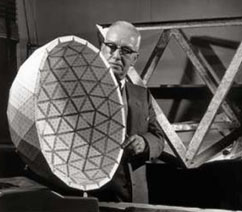A “Jack of all trades” genius only comes around once in a rare lifetime, but Buckminster Fuller was one such revolutionary mind. Fuller’s “Dymaxion” agenda, a purely utopian method of looking at design, is best exemplified through the geodesic dome.
Right away the dome proved to be innovative and highly sustainable proving that weight had no practical limits. The structure was 4.3 meters in diameter and constructed of aluminum aircraft tubing in the form of an icosahedron. In order to put his critic’s minds to rest, Fuller suspended sever al students from the structural framework to prove that the design defied the outward appearance of physics.
al students from the structural framework to prove that the design defied the outward appearance of physics.
But the dome inspired the scope of sustainability to expand beyond pure design. Continue reading to learn how his work is enabling the brightest minds to come together and work under the Fuller umbrella to make the world a better place.
Moving forward
Today Buckminster Fuller and his innovative genius survive and exist through contributions towards global good. For example, the Buckminster Fuller Challenge offers a design competition that awards $100,000 to support the development of a strategy that has great potential to some of humanity’s most pressing problems. Some past winners lead to having their personal transport devices developed.
Furthermore, carbon-neutral structures built in Appalachia were inspired by the geodesic dome and serve as sustainable structures. This prize also lead to innovative grassland management systems in Africa that have improved the agriculture, and the lives of thousands.
Meeting the needs of critical importance
When contests attract visionary minds with initiatives focused on a well-defined need for critical and global points of importance, the technologies of tomorrow aid in solving some our centuries biggest challenges.
Finding ways to be less reliant of fuel and electricity and finding global green solutions is always a top priority for such research. These solutions are often heavily based in the foundation of new technologies. Being sustainable and making sure we don’t exhaust our natural resources are major concerns being addressed in the scientific challenges made by Fuller’s legacy within today’s global community. And as technologies advance, new possibilities to solve global concerns arise.
Research
The Fuller legacy continues to nurture scientific projects today that will improve the way the world works by nurturing the young minds of the scientific community to contribute towards the global good.
One runner up in the Buckminster Fuller Challenge was a project concerning overfishing. In the attempt to better understand this global problem, many barriers had to be overcome including ones of policy, commerce environment and livelihood.
How we as a human race hunt, eat, and protect fish is vital to sustaining our quality of life while protecting the environment. Considering that 1 billion people on the planet rely on fish as their primary source of protein and that 85 percent of the planet’s fisheries are harvested at or even well beyond their limits is troubling and a solution must be reached. The cash prize challenge sets off to reward those who can come up with good solutions to alarming concerns such as this one.
The legacy
Buckminster Fuller and his legacy’s organizations continue to gather the brightest minds and embrace his work through innovative projects that will help in making the world a better place.
Image source: http://www.dahp.wa.gov/sites/default/files/BuckminsterFuller.jpg










Comments